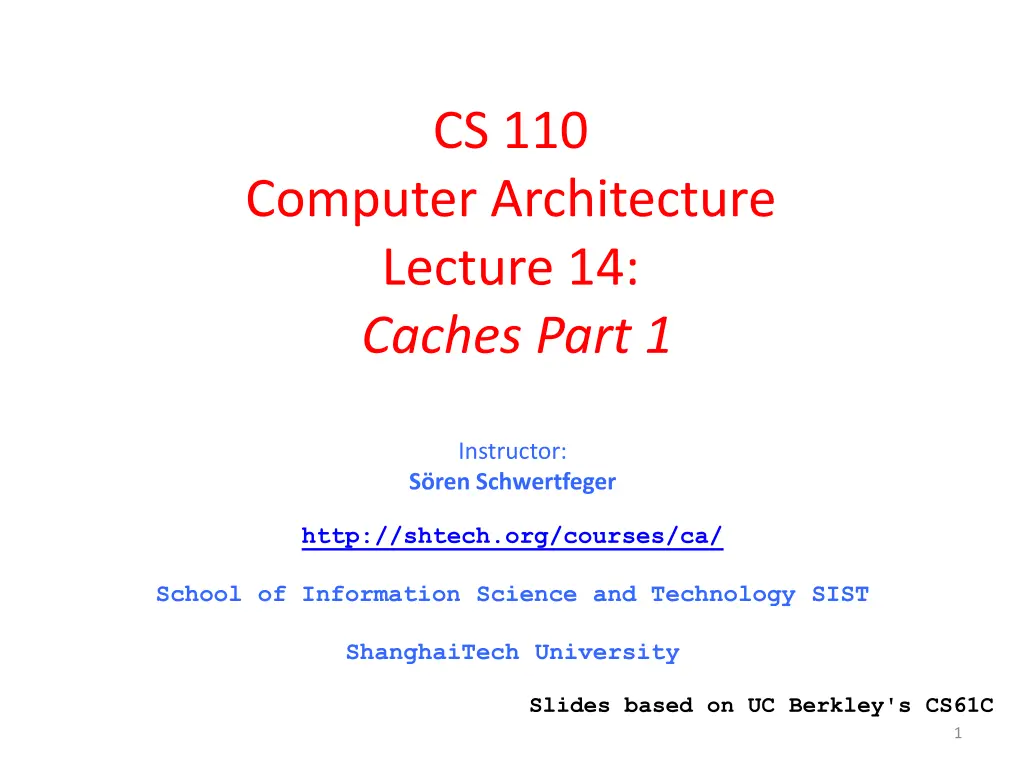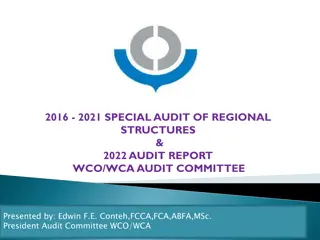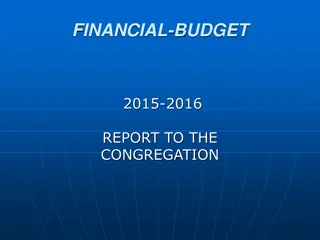
Computer Architecture Lecture on Caches at ShanghaiTech University
Explore the intricacies of computer architecture and memory hierarchies in this lecture on caches at ShanghaiTech University, presented by Instructor S. Schwertfeger. Learn about the challenges and solutions in achieving high performance in computer systems through parallel processing and memory optimization. Delve into topics such as the Processor-DRAM Gap, memory hierarchy, and the impact of memory latency on CPU performance.
Download Presentation

Please find below an Image/Link to download the presentation.
The content on the website is provided AS IS for your information and personal use only. It may not be sold, licensed, or shared on other websites without obtaining consent from the author. If you encounter any issues during the download, it is possible that the publisher has removed the file from their server.
You are allowed to download the files provided on this website for personal or commercial use, subject to the condition that they are used lawfully. All files are the property of their respective owners.
The content on the website is provided AS IS for your information and personal use only. It may not be sold, licensed, or shared on other websites without obtaining consent from the author.
E N D
Presentation Transcript
CS 110 Computer Architecture Lecture 14: Caches Part 1 Instructor: S ren Schwertfeger http://shtech.org/courses/ca/ School of Information Science and Technology SIST ShanghaiTech University Slides based on UC Berkley's CS61C 1
New-School Machine Structures (It s a bit more complicated!) Software Hardware Parallel Requests Assigned to computer e.g., Search Katz Parallel Threads Assigned to core e.g., Lookup, Ads Parallel Instructions >1 instruction @ one time e.g., 5 pipelined instructions Parallel Data >1 data item @ one time e.g., Add of 4 pairs of words Hardware descriptions All gates @ one time Programming Languages Smart Phone Warehouse Scale Computer Harness Parallelism & Achieve High Performance How do we know? Computer Core Core Memory (Cache) Input/Output Core Functional Unit(s) Instruction Unit(s) A3+B3 A2+B2 A1+B1 A0+B0 Cache Memory Logic Gates 2
Components of a Computer Memory Processor Input Enable? Read/Write Control Program Datapath Address Bytes PC Write Data Registers Data Read Data Arithmetic & Logic Unit (ALU) Output Processor-Memory Interface I/O-Memory Interfaces 3
Problem: Large memories slow? Library Analogy Finding a book in a large library takes time Takes time to search a large card catalog (mapping title/author to index number) Round-trip time to walk to the stacks and retrieve the desired book. Larger libraries makes both delays worse Electronic memories have the same issue, plus the technologies that we use to store an individual bit get slower as we increase density (SRAM versus DRAM versus Magnetic Disk) However what we want is a large yet fast memory! 4
Processor-DRAM Gap (latency) Proc 60%/year 1000 CPU Performance Processor-Memory Performance Gap: (growing 50%/yr) 100 10 DRAM 7%/year DRAM 1 1988 1986 1987 1989 1990 1991 1992 1993 1994 1995 1996 1981 1980 1982 1983 1984 1985 1997 1998 1999 2000 Time 1980 microprocessor executes ~one instruction in same time as DRAM access 2015 microprocessor executes ~1000 instructions in same time as DRAM access Slow DRAM access could have disastrous impact on CPU performance! 5
Big Idea: Memory Hierarchy Processor Increasing distance from processor, decreasing speed Inner Level 1 Levels in memory hierarchy Level 2 Level 3 . . . Outer Level n Size of memory at each level As we move to outer levels the latency goes up and price per bit goes down. Why? 6
What to do: Library Analogy Want to write a report using library books Go to library, look up relevant books, fetch from stacks, and place on desk in library If need more, check them out and keep on desk But don t return earlier books since might need them You hope this collection of ~10 books on desk enough to write report, despite 10 being only a tiny fraction of books available 7
Real Memory Reference Patterns Memory Address (one dot per access) Time Donald J. Hatfield, Jeanette Gerald: Program Restructuring for Virtual Memory. IBM Systems Journal 10(3): 168-192 (1971)
Big Idea: Locality Temporal Locality (locality in time) Go back to same book on desktop multiple times If a memory location is referenced, then it will tend to be referenced again soon Spatial Locality (locality in space) When go to book shelf, pick up multiple books on J.D. Salinger since library stores related books together If a memory location is referenced, the locations with nearby addresses will tend to be referenced soon 9
Memory Reference Patterns Memory Address (one dot per access) Temporal Locality Spatial Locality Time Donald J. Hatfield, Jeanette Gerald: Program Restructuring for Virtual Memory. IBM Systems Journal 10(3): 168-192 (1971)
Principle of Locality Principle of Locality: Programs access small portion of address space at any instant of time (spatial locality) and repeatedly access that portion (temporal locality) What program structures lead to temporal and spatial locality in instruction accesses? In data accesses? 11
Memory Reference Patterns Address n loop iterations Instruction fetches subroutine call subroutine return Stack accesses argument access Data accesses scalar accesses Time
Cache Philosophy Programmer-invisible hardware mechanism to give illusion of speed of fastest memory with size of largest memory Works fine even if programmer has no idea what a cache is However, performance-oriented programmers today sometimes reverse engineer cache design to design data structures to match cache 13
Memory Access without Cache Load word instruction: lw $t0,0($t1) $t1 contains 1022ten, Memory[1022] = 99 1. Processor issues address 1022ten to Memory 2. Memory reads word at address 1022ten (99) 3. Memory sends 99 to Processor 4. Processor loads 99 into register $t0 14
Adding Cache to Computer Memory Processor Input Enable? Read/Write Control Program Cache Datapath Address Bytes PC Write Data Registers Data Arithmetic & Logic Unit (ALU) Read Data Output Processor-Memory Interface I/O-Memory Interfaces 15
Memory Access with Cache Load word instruction: lw $t0,0($t1) $t1 contains 1022ten, Memory[1022] = 99 With cache: Processor issues address 1022ten to Cache 1. Cache checks to see if has copy of data at address 1022ten 2a. If finds a match (Hit): cache reads 99, sends to processor 2b. No match (Miss): cache sends address 1022 to Memory I. Memory reads 99 at address 1022ten II. Memory sends 99 to Cache III. Cache replaces word with new 99 IV. Cache sends 99 to processor 2. Processor loads 99 into register $t0 16
Administrivia Midterm 1 Go through all questions at todays discussion Grading for the course will be relative, not absolute Postpone HW5 or Project 1.2? 17
Cache Tags Need way to tell if have copy of location in memory so that can decide on hit or miss On cache miss, put memory address of block in tag address of cache block 1022 placed in tag next to data from memory (99) Tag 252 1022 131 2041 Data 12 99 7 20 From earlier instructions 18
Anatomy of a 16 Byte Cache, 4 Byte Block Operations: 1. Cache Hit 2. Cache Miss 3. Refill cache from memory Cache needs Address Tags to decide if Processor Address is a Cache Hit or Cache Miss Compares all 4 tags Processor 32-bit Address 32-bit Data 12 252 99 7 20 1022 131 2041 Cache 32-bit Address 32-bit Data Memory 19
Cache Replacement Suppose processor now requests location 511, which contains 11? Doesn t match any cache block, so must evict one resident block to make room Which block to evict? Replace victim with new memory block at address 511 Tag Tag 252 1022 511 2041 Data Data 12 99 11 20 252 12 1022 99 131 7 2041 20 20
Block Must be Aligned in Memory Word blocks are aligned, so binary address of all words in cache always ends in 00two How to take advantage of this to save hardware and energy? Don t need to compare last 2 bits of 32-bit byte address (comparator can be narrower) => Don t need to store last 2 bits of 32-bit byte address in Cache Tag (Tag can be narrower) 21
Anatomy of a 32B Cache, 8B Block Blocks must be aligned in pairs, otherwise could get same word twice in cache Tags only have even- numbered words Last 3 bits of address always 000two Tags, comparators can be narrower Can get hit for either word in block Processor 32-bit Data 32-bit Address 12 252 -10 99 42 1947 1000 7 20 1022 130 2040 Cache 32-bit Address 32-bit Data Memory 22
Hardware Cost of Cache Need to compare every tag to the Processor address Comparators are expensive Optimization: use 2 sets of data with a total of only 2 comparators 1 Address bit selects which set Compare only tags from selected set Generalize to more sets Processor 32-bit Address 32-bit Data Tag Tag Data Data Set 0 Set 1 Tag Tag Data Data Cache 32-bit Address 32-bit Data Memory 2323
Processor Address Fields used by Cache Controller Block Offset: Byte address within block Set Index: Selects which set Tag: Remaining portion of processor address Processor Address (32-bits total) Block offset Set Index Tag Size of Index = log2 (number of sets) Size of Tag = Address size Size of Index log2 (number of bytes/block) 24
What is limit to number of sets? For a given total number of blocks, we can save more comparators if have more than 2 sets Limit: As Many Sets as Cache Blocks => only one block per set only needs one comparator! Called Direct-Mapped Design Block offset Index Tag 25
Direct Mapped Cache Ex: Mapping a 6-bit Memory Address 4 3 2 1 0 5 Tag Index Byte Offset Byte Within Block Block Within $ Mem Block Within $ Block In example, block size is 4 bytes/1 word Memory and cache blocks always the same size, unit of transfer between memory and cache # Memory blocks >> # Cache blocks 16 Memory blocks = 16 words = 64 bytes => 6 bits to address all bytes 4 Cache blocks, 4 bytes (1 word) per block 4 Memory blocks map to each cache block Memory block to cache block, aka index: middle two bits Which memory block is in a given cache block, aka tag: top two bits 26
One More Detail: Valid Bit When start a new program, cache does not have valid information for this program Need an indicator whether this tag entry is valid for this program Add a valid bit to the cache tag entry 0 => cache miss, even if by chance, address = tag 1 => cache hit, if processor address = tag 27
Caching: A Simple First Example Main Memory 0000xx 0001xx 0010xx 0011xx 0100xx 0101xx 0110xx 0111xx 1000xx 1001xx 1010xx 1011xx 1100xx 1101xx 1110xx 1111xx One word blocks Two low order bits (xx) define the byte in the block (32b words) Cache Index Valid Tag Data 00 01 10 11 Q: Where in the cache is the mem block? Q: Is the memory block in cache? Compare the cache tag to the high-order 2 memory address bits to tell if the memory block is in the cache (provided valid bit is set) Use next 2 low-order memory address bits the index to determine which cache block (i.e., modulo the number of blocks in the cache) 28
Direct-Mapped Cache Example One word blocks, cache size = 1K words (or 4KB) Byte offset 31 30 . . . 13 12 11 . . . 2 1 0 Tag 20 Index 10 Data Hit Valid bit ensures something useful in cache for this index Read data from cache instead of memory if a Hit Index Valid Tag Data 0 1 2 . . . 1021 1022 1023 Compare Tag with upper part of Address to see if a Hit 32 20 Comparator What kind of locality are we taking advantage of? 29
Multiword-Block Direct-Mapped Cache Four words/block, cache size = 1K words 31 30 . . . Hit Byte offset 13 12 11 . . . 4 3 2 1 0 Data 2 Word offset Tag 20 8 Index Data Index Valid Tag 0 1 2 . . . 253 254 255 20 32 What kind of locality are we taking advantage of? 30
Cache Names for Each Organization Fully Associative : Block can go anywhere First design in lecture Note: No Index field, but 1 comparator/block Direct Mapped : Block goes one place Note: Only 1 comparator Number of sets = number blocks N-way Set Associative : N places for a block Number of sets = number of blocks / N N comparators Fully Associative: N = number of blocks Direct Mapped: N = 1 31
Range of Set-Associative Caches For a fixed-size cache, and a given block size, each increase by a factor of 2 in associativity doubles the number of blocks per set (i.e., the number of ways ) and halves the number of sets decreases the size of the index by 1 bit and increases the size of the tag by 1 bit More Associativity (more ways) Block offset Index Tag What if we can also change the block size? 32
Question For a cache with constant total capacity, if we increase the number of ways by a factor of 2, which statement is false: A: The number of sets could be doubled B: The tag width could decrease C: The block size could stay the same D: The block size could be halved E: Tag width must increase 33
Total Cash Capacity = Associativity * # of sets * block_size Bytes = blocks/set * sets * Bytes/block C = N * S * B Tag Index Byte Offset address_size = tag_size + index_size + offset_size = tag_size + log2(S) + log2(B) Clicker Question: C remains constant, S and/or B can change such that C = 2N * (SB) => (SB) = SB/2 Tag_size = address_size (log2(S) + log2(B)) = address_size log2(SB) = address_size (log2(SB) 1) 34
Typical Memory Hierarchy On-Chip Components Control Third- Level Cache (SRAM) Secondary Memory (Disk Or Flash) Cache Main Memory (DRAM) Instr Second- Level Cache (SRAM) Datapath RegFile Cache Data Speed (cycles): s 1 s 10 s 100 s 1,000,000 s Size (bytes): 100 s 10K s M s G s T s Cost/bit: highest lowest Principle of locality + memory hierarchy presents programmer with as much memory as is available in the cheapest technology at the speed offered by the fastest technology 35
Handling Stores with Write-Through Store instructions write to memory, changing values Need to make sure cache and memory have same values on writes: 2 policies 1) Write-Through Policy: write cache and write through the cache to memory Every write eventually gets to memory Too slow, so include Write Buffer to allow processor to continue once data in Buffer Buffer updates memory in parallel to processor 36
Write-Through Cache Write both values in cache and in memory Write buffer stops CPU from stalling if memory cannot keep up Write buffer may have multiple entries to absorb bursts of writes What if store misses in cache? Processor 32-bit Address 32-bit Data Cache 12 252 99 7 1022 131 2041 Write Buffer 20 Addr Data 32-bit Address 32-bit Data Memory 37
Handling Stores with Write-Back 2) Write-Back Policy: write only to cache and then write cache block back to memory when evict block from cache Writes collected in cache, only single write to memory per block Include bit to see if wrote to block or not, and then only write back if bit is set Called Dirty bit (writing makes it dirty ) 38
Write-Back Cache Processor Store/cache hit, write data in cache only & set dirty bit Memory has stale value Store/cache miss, read data from memory, then update and set dirty bit Write-allocate policy Load/cache hit, use value from cache On any miss, write back evicted block, only if dirty. Update cache with new block and clear dirty bit. 32-bit Address 32-bit Data Cache 12 252 D D D D 99 7 1022 131 2041 Dirty Bits 20 32-bit Address 32-bit Data Memory 39
Write-Through vs. Write-Back Write-Through: Simpler control logic More predictable timing simplifies processor control logic Easier to make reliable, since memory always has copy of data (big idea: Redundancy!) Write-Back More complex control logic More variable timing (0,1,2 memory accesses per cache access) Usually reduces write traffic Harder to make reliable, sometimes cache has only copy of data 40
And In Conclusion, Principle of Locality for Libraries /Computer Memory Hierarchy of Memories (speed/size/cost per bit) to Exploit Locality Cache copy of data lower level in memory hierarchy Direct Mapped to find block in cache using Tag field and Valid bit for Hit Cache design choice: Write-Through vs. Write-Back 41






















